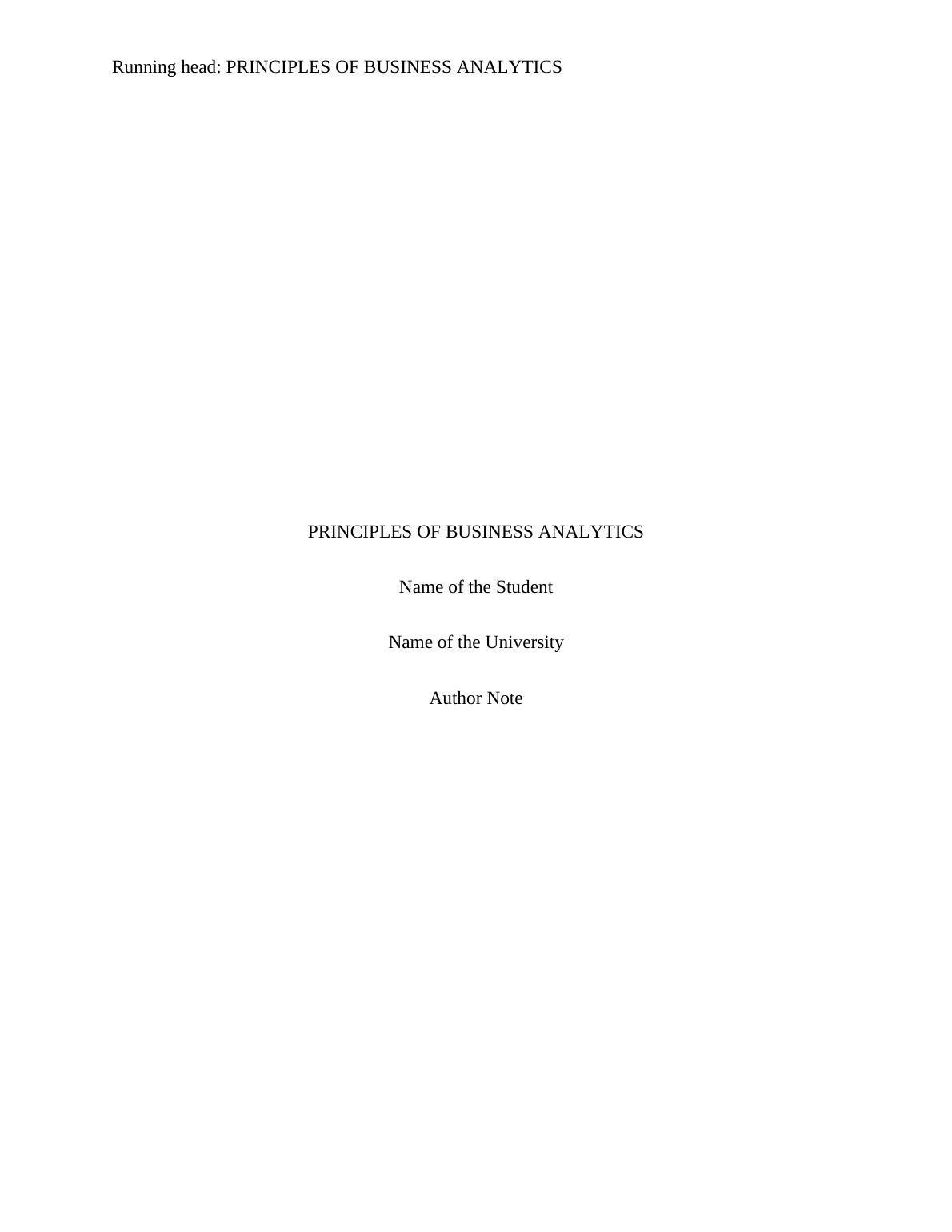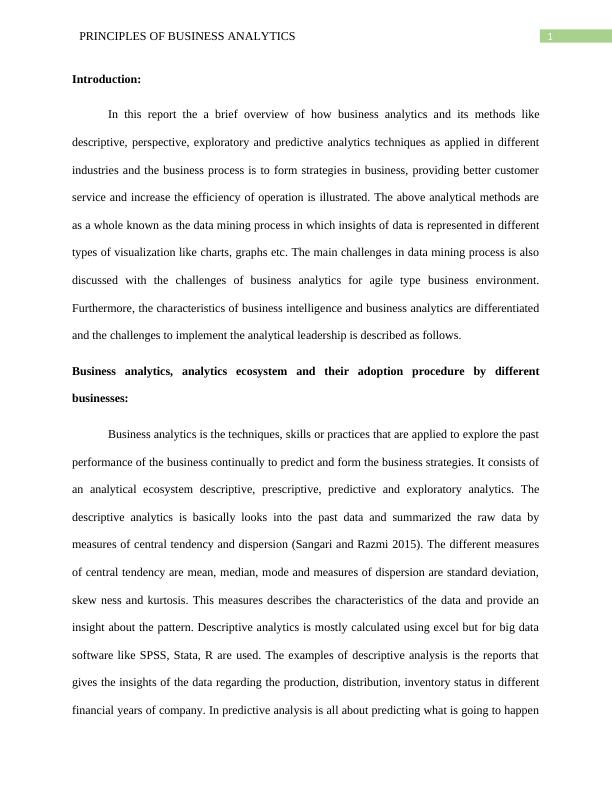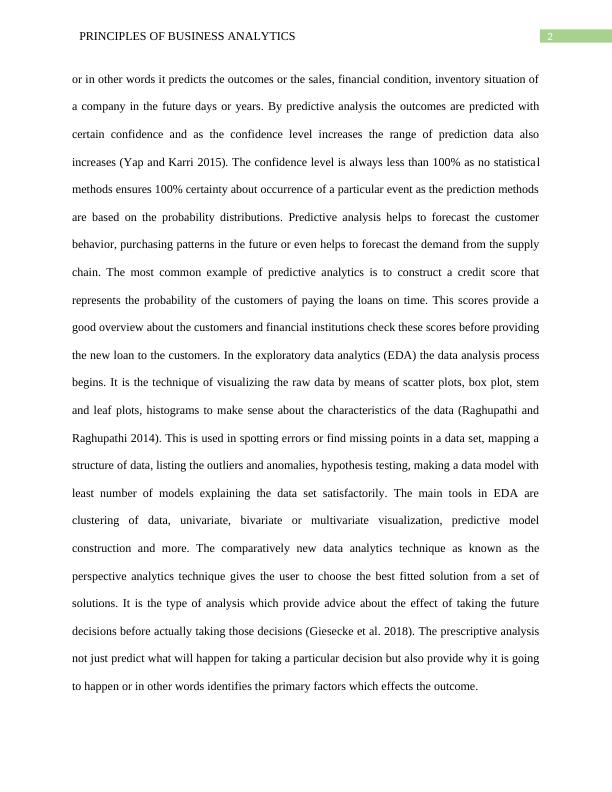Principles of Business Analytics: Methods, Challenges, and Adoption
Added on 2023-06-04
9 Pages2288 Words366 Views
Running head: PRINCIPLES OF BUSINESS ANALYTICS
PRINCIPLES OF BUSINESS ANALYTICS
Name of the Student
Name of the University
Author Note
PRINCIPLES OF BUSINESS ANALYTICS
Name of the Student
Name of the University
Author Note

1PRINCIPLES OF BUSINESS ANALYTICS
Introduction:
In this report the a brief overview of how business analytics and its methods like
descriptive, perspective, exploratory and predictive analytics techniques as applied in different
industries and the business process is to form strategies in business, providing better customer
service and increase the efficiency of operation is illustrated. The above analytical methods are
as a whole known as the data mining process in which insights of data is represented in different
types of visualization like charts, graphs etc. The main challenges in data mining process is also
discussed with the challenges of business analytics for agile type business environment.
Furthermore, the characteristics of business intelligence and business analytics are differentiated
and the challenges to implement the analytical leadership is described as follows.
Business analytics, analytics ecosystem and their adoption procedure by different
businesses:
Business analytics is the techniques, skills or practices that are applied to explore the past
performance of the business continually to predict and form the business strategies. It consists of
an analytical ecosystem descriptive, prescriptive, predictive and exploratory analytics. The
descriptive analytics is basically looks into the past data and summarized the raw data by
measures of central tendency and dispersion (Sangari and Razmi 2015). The different measures
of central tendency are mean, median, mode and measures of dispersion are standard deviation,
skew ness and kurtosis. This measures describes the characteristics of the data and provide an
insight about the pattern. Descriptive analytics is mostly calculated using excel but for big data
software like SPSS, Stata, R are used. The examples of descriptive analysis is the reports that
gives the insights of the data regarding the production, distribution, inventory status in different
financial years of company. In predictive analysis is all about predicting what is going to happen
Introduction:
In this report the a brief overview of how business analytics and its methods like
descriptive, perspective, exploratory and predictive analytics techniques as applied in different
industries and the business process is to form strategies in business, providing better customer
service and increase the efficiency of operation is illustrated. The above analytical methods are
as a whole known as the data mining process in which insights of data is represented in different
types of visualization like charts, graphs etc. The main challenges in data mining process is also
discussed with the challenges of business analytics for agile type business environment.
Furthermore, the characteristics of business intelligence and business analytics are differentiated
and the challenges to implement the analytical leadership is described as follows.
Business analytics, analytics ecosystem and their adoption procedure by different
businesses:
Business analytics is the techniques, skills or practices that are applied to explore the past
performance of the business continually to predict and form the business strategies. It consists of
an analytical ecosystem descriptive, prescriptive, predictive and exploratory analytics. The
descriptive analytics is basically looks into the past data and summarized the raw data by
measures of central tendency and dispersion (Sangari and Razmi 2015). The different measures
of central tendency are mean, median, mode and measures of dispersion are standard deviation,
skew ness and kurtosis. This measures describes the characteristics of the data and provide an
insight about the pattern. Descriptive analytics is mostly calculated using excel but for big data
software like SPSS, Stata, R are used. The examples of descriptive analysis is the reports that
gives the insights of the data regarding the production, distribution, inventory status in different
financial years of company. In predictive analysis is all about predicting what is going to happen

2PRINCIPLES OF BUSINESS ANALYTICS
or in other words it predicts the outcomes or the sales, financial condition, inventory situation of
a company in the future days or years. By predictive analysis the outcomes are predicted with
certain confidence and as the confidence level increases the range of prediction data also
increases (Yap and Karri 2015). The confidence level is always less than 100% as no statistical
methods ensures 100% certainty about occurrence of a particular event as the prediction methods
are based on the probability distributions. Predictive analysis helps to forecast the customer
behavior, purchasing patterns in the future or even helps to forecast the demand from the supply
chain. The most common example of predictive analytics is to construct a credit score that
represents the probability of the customers of paying the loans on time. This scores provide a
good overview about the customers and financial institutions check these scores before providing
the new loan to the customers. In the exploratory data analytics (EDA) the data analysis process
begins. It is the technique of visualizing the raw data by means of scatter plots, box plot, stem
and leaf plots, histograms to make sense about the characteristics of the data (Raghupathi and
Raghupathi 2014). This is used in spotting errors or find missing points in a data set, mapping a
structure of data, listing the outliers and anomalies, hypothesis testing, making a data model with
least number of models explaining the data set satisfactorily. The main tools in EDA are
clustering of data, univariate, bivariate or multivariate visualization, predictive model
construction and more. The comparatively new data analytics technique as known as the
perspective analytics technique gives the user to choose the best fitted solution from a set of
solutions. It is the type of analysis which provide advice about the effect of taking the future
decisions before actually taking those decisions (Giesecke et al. 2018). The prescriptive analysis
not just predict what will happen for taking a particular decision but also provide why it is going
to happen or in other words identifies the primary factors which effects the outcome.
or in other words it predicts the outcomes or the sales, financial condition, inventory situation of
a company in the future days or years. By predictive analysis the outcomes are predicted with
certain confidence and as the confidence level increases the range of prediction data also
increases (Yap and Karri 2015). The confidence level is always less than 100% as no statistical
methods ensures 100% certainty about occurrence of a particular event as the prediction methods
are based on the probability distributions. Predictive analysis helps to forecast the customer
behavior, purchasing patterns in the future or even helps to forecast the demand from the supply
chain. The most common example of predictive analytics is to construct a credit score that
represents the probability of the customers of paying the loans on time. This scores provide a
good overview about the customers and financial institutions check these scores before providing
the new loan to the customers. In the exploratory data analytics (EDA) the data analysis process
begins. It is the technique of visualizing the raw data by means of scatter plots, box plot, stem
and leaf plots, histograms to make sense about the characteristics of the data (Raghupathi and
Raghupathi 2014). This is used in spotting errors or find missing points in a data set, mapping a
structure of data, listing the outliers and anomalies, hypothesis testing, making a data model with
least number of models explaining the data set satisfactorily. The main tools in EDA are
clustering of data, univariate, bivariate or multivariate visualization, predictive model
construction and more. The comparatively new data analytics technique as known as the
perspective analytics technique gives the user to choose the best fitted solution from a set of
solutions. It is the type of analysis which provide advice about the effect of taking the future
decisions before actually taking those decisions (Giesecke et al. 2018). The prescriptive analysis
not just predict what will happen for taking a particular decision but also provide why it is going
to happen or in other words identifies the primary factors which effects the outcome.

End of preview
Want to access all the pages? Upload your documents or become a member.
Related Documents
Principles of Business Analytics: Importance, Ecosystem, Data Mining, Challenges, and Leadershiplg...
|12
|2804
|477
Principles of Business Analyticslg...
|15
|2703
|473
Techniques of Predictive Analysislg...
|5
|2073
|392
Predictive Analytics in Financial Servicelg...
|5
|1217
|38
Business Research Methodology Analysis 2022lg...
|4
|775
|38
Assignment(doc) on Business Analytics 2022lg...
|15
|2810
|18
